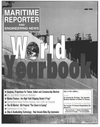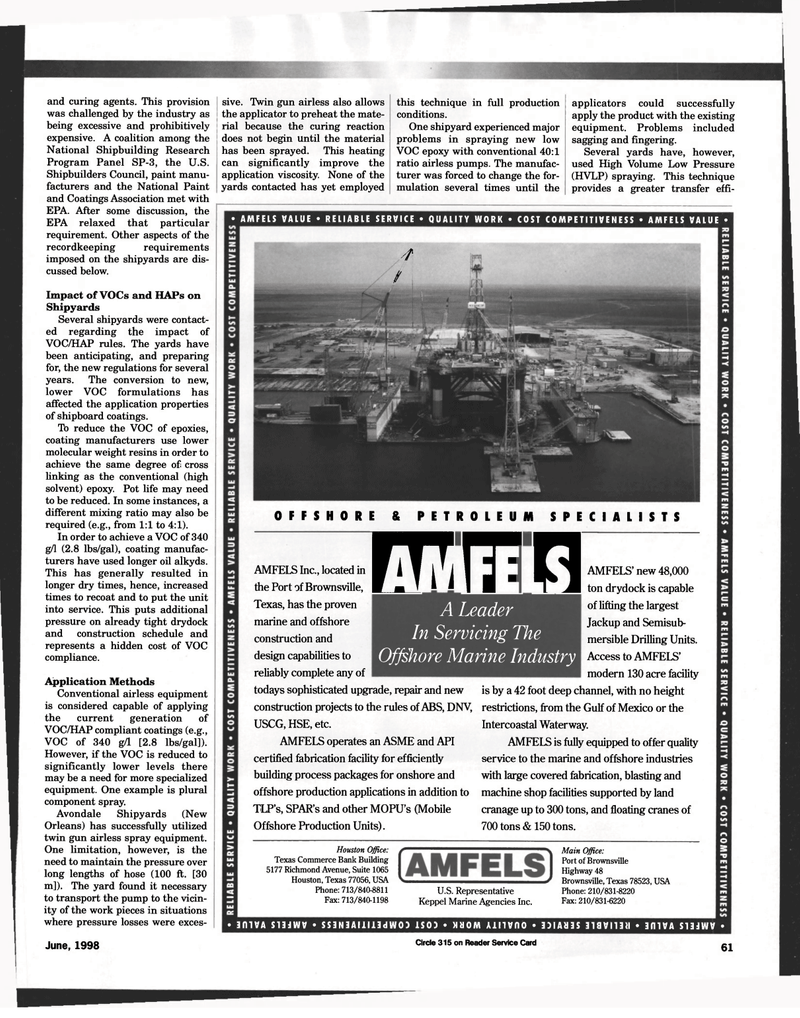
Page 80: of Maritime Reporter Magazine (June 1998)
Read this page in Pdf, Flash or Html5 edition of June 1998 Maritime Reporter Magazine
and curing agents. This provision was challenged by the industry as being excessive and prohibitively expensive. A coalition among the
National Shipbuilding Research
Program Panel SP-3, the U.S.
Shipbuilders Council, paint manu- facturers and the National Paint and Coatings Association met with
EPA. After some discussion, the
EPA relaxed that particular requirement. Other aspects of the recordkeeping requirements imposed on the shipyards are dis- cussed below.
Impact of VOCs and HAPs on
Shipyards
Several shipyards were contact- ed regarding the impact of
VOC/HAP rules. The yards have been anticipating, and preparing for, the new regulations for several years. The conversion to new, lower VOC formulations has affected the application properties of shipboard coatings.
To reduce the VOC of epoxies, coating manufacturers use lower molecular weight resins in order to achieve the same degree of cross linking as the conventional (high solvent) epoxy. Pot life may need to be reduced. In some instances, a different mixing ratio may also be required (e.g., from 1:1 to 4:1).
In order to achieve a VOC of 340 g/1 (2.8 lbs/gal), coating manufac- turers have used longer oil alkyds.
This has generally resulted in longer dry times, hence, increased times to recoat and to put the unit into service. This puts additional pressure on already tight drydock and construction schedule and represents a hidden cost of VOC compliance.
Application Methods
Conventional airless equipment is considered capable of applying the current generation of
VOC/HAP compliant coatings (e.g.,
VOC of 340 g/1 [2.8 lbs/gal]).
However, if the VOC is reduced to significantly lower levels there may be a need for more specialized equipment. One example is plural component spray.
Avondale Shipyards (New
Orleans) has successfully utilized twin gun airless spray equipment.
One limitation, however, is the need to maintain the pressure over long lengths of hose (100 ft. [30 m]). The yard found it necessary to transport the pump to the vicin- ity of the work pieces in situations where pressure losses were exces- sive. Twin gun airless also allows the applicator to preheat the mate- rial because the curing reaction does not begin until the material has been sprayed. This heating can significantly improve the application viscosity. None of the yards contacted has yet employed this technique in full production conditions.
One shipyard experienced major problems in spraying new low
VOC epoxy with conventional 40:1 ratio airless pumps. The manufac- turer was forced to change the for- mulation several times until the applicators could successfully apply the product with the existing equipment. Problems included sagging and fingering.
Several yards have, however, used High Volume Low Pressure (HVLP) spraying. This technique provides a greater transfer effi- • AMFELS VALUE • RELIABLE SERVICE • QUALITY WORK • COST COMPETITIVENESS • AMFELS VALUE • // /
OFFSHORE & PETROLEUM SPECIALISTS
LUWM AMFELS Inc., located in the Port of Brownsville,
Texas, has the proven marine and offshore construction and design capabilities to reliably complete any of todays sophisticated upgrade, repair and new construction projects to the rules of ABS, DNV,
USCG, HSE, etc.
AMFELS operates an ASME and API certified fabrication facility for efficiently building process packages for onshore and offshore production applications in addition to
TLP's, SPAR's and other MOPU's (Mobile
Offshore Production Units).
A Leader
In Servicing The
Offshore Marine Industry
AMFELS' new 48,000 ton drydock is capable of lifting the largest
Jackup and Semisub- mersible Drilling Units.
Access to AMFELS' modern 130 acre facility is by a 42 foot deep channel, with no height restrictions, from the Gulf of Mexico or the
Intercoastal Waterway.
AMFELS is fully equipped to offer quality service to the marine and offshore industries with large covered fabrication, blasting and machine shop facilities supported by land cranage up to 300 tons, and floating cranes of 700 tons & 150 tons.
Houston Office:
Texas Commerce Bank Building 5177 Richmond Avenue, Suite 1065
Houston, Texas 77056, USA
Phone: 713/840-8811
Fax: 713/840-1198
U.S. Representative
Keppel Marine Agencies Inc.
Main Office:
Port of Brownsville
Highway 48
Brownsville, Texas 78523, USA
Phone: 210/831-8220
Fax: 210/831-6220 • 3MVA S13JWV • SS3N3Allil3dWO} ISO) • MHOM AlllVDO • 331 Ad IS 319VI132I • 3(11 VA S13JWV •
June, 1998 Circle 315 on Reader Service Card 61

 79
79

 81
81
